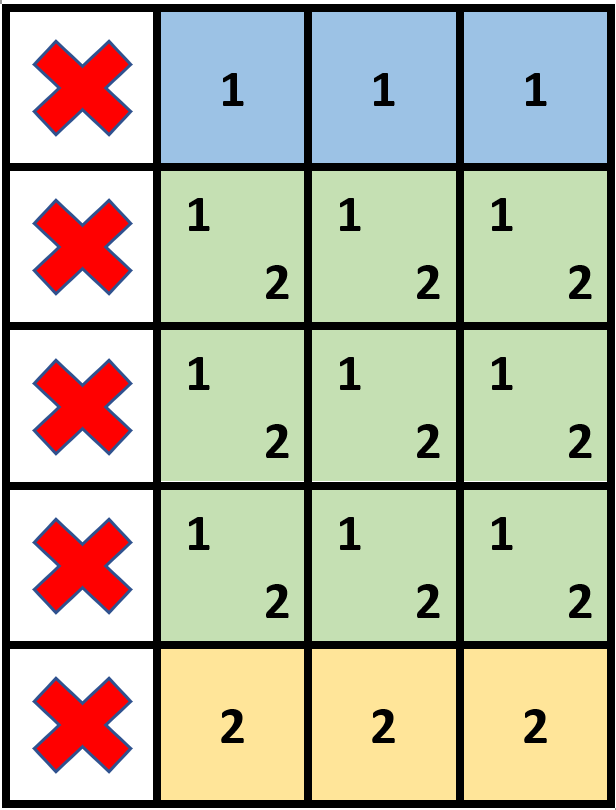- {x}
- Check if All A's Appears Before All B's
- Number of Laser Beams in a Bank
- Destroying Asteroids
- Maximum Employees to Be Invited to a Meeting
- Remove All Ones With Row and Column Flips
- Capitalize the Title
- Maximum Twin Sum of a Linked List
- Longest Palindrome by Concatenating Two Letter Words
- Stamping the Grid
- Check if Every Row and Column Contains All Numbers
- Minimum Swaps to Group All 1's Together II
- Count Words Obtained After Adding a Letter
- Earliest Possible Day of Full Bloom
- Pour Water Between Buckets to Make Water Levels Equal
- Divide a String Into Groups of Size k
- Minimum Moves to Reach Target Score
- Solving Questions With Brainpower
- Read More...

Stamping the Grid
You are given an m x n binary matrix grid where each cell is either 0 (empty) or 1 (occupied).
You are then given stamps of size stampHeight x stampWidth. We want to fit the stamps such that they follow the given restrictions and requirements:
- Cover all the empty cells.
- Do not cover any of the occupied cells.
- We can put as many stamps as we want.
- Stamps can overlap with each other.
- Stamps are not allowed to be rotated.
- Stamps must stay completely inside the grid.
Return true if it is possible to fit the stamps while following the given restrictions and requirements. Otherwise, return false.
Example 1:

Input: grid = [[1,0,0,0],[1,0,0,0],[1,0,0,0],[1,0,0,0],[1,0,0,0]], stampHeight = 4, stampWidth = 3 Output: true Explanation: We have two overlapping stamps (labeled 1 and 2 in the image) that are able to cover all the empty cells.
Example 2:

Input: grid = [[1,0,0,0],[0,1,0,0],[0,0,1,0],[0,0,0,1]], stampHeight = 2, stampWidth = 2 Output: false Explanation: There is no way to fit the stamps onto all the empty cells without the stamps going outside the grid.
Constraints:
m == grid.lengthn == grid[r].length1 <= m, n <= 1051 <= m * n <= 2 * 105grid[r][c]is either0or1.1 <= stampHeight, stampWidth <= 105
Solution Explanation: Stamping the Grid
This problem asks whether we can cover all empty cells in a grid using non-rotatable stamps of a fixed size without covering any occupied cells. The solution uses a clever combination of prefix sums and difference arrays to efficiently check this condition.
Approach:
-
Prefix Sum Array: A 2D prefix sum array
sis created.s[i][j]stores the total number of occupied cells (1s) in the subgrid from (0,0) to (i,j). This allows for O(1) calculation of the number of occupied cells in any rectangular subgrid. -
Iteration and Stamp Placement: The code iterates through the grid. For each cell (i,j), it checks if placing a stamp with its top-left corner at (i,j) is valid:
- It calculates the number of occupied cells within the potential stamp area using the prefix sum array. If this count is 0 (all cells are empty), the stamp placement is valid.
- If valid, a difference array
dis updated. The difference array tracks the change in the number of stamp coverings for each cell. Adding a stamp increments the count at (i,j), decrements at the bottom and right edges, and increments again at the bottom-right corner. This is a standard technique for efficiently applying changes across a rectangular region.
-
Difference Array to Coverage: After iterating through all possible stamp positions, the difference array
dis converted to a coverage array by performing a prefix sum ond.d[i][j]now represents the total number of stamps covering cell (i,j). -
Validation: Finally, the code checks if all empty cells (0s in the original grid) have a non-zero coverage value in
d. If any empty cell has a coverage of 0, it means it cannot be covered by any stamp, and the function returnsfalse. Otherwise, it returnstrue.
Time and Space Complexity:
- Time Complexity: O(m*n), where 'm' and 'n' are the dimensions of the grid. This is dominated by the nested loops for iterating through the grid and calculating prefix sums.
- Space Complexity: O(m*n), due to the prefix sum array
sand the difference arrayd.
Code Explanations (Python3 as Example):
The Python code implements the steps described above. The comments within the code provide a detailed explanation of each part. The other language implementations follow the same logic, with only syntax differences.
class Solution:
def possibleToStamp(self, grid: List[List[int]], stampHeight: int, stampWidth: int) -> bool:
m, n = len(grid), len(grid[0])
s = [[0] * (n + 1) for _ in range(m + 1)] # Initialize prefix sum array
#Calculate prefix sums
for i in range(1, m + 1):
for j in range(1, n + 1):
s[i][j] = s[i - 1][j] + s[i][j - 1] - s[i - 1][j - 1] + grid[i - 1][j - 1]
d = [[0] * (n + 2) for _ in range(m + 2)] #Initialize difference array
#Iterate and update difference array based on valid stamp placements
for i in range(1, m - stampHeight + 2):
for j in range(1, n - stampWidth + 2):
x, y = i + stampHeight - 1, j + stampWidth - 1
#Check if stamp placement is valid
if s[x][y] - s[x][j - 1] - s[i - 1][y] + s[i - 1][j - 1] == 0:
d[i][j] += 1
d[i][y + 1] -= 1
d[x + 1][j] -= 1
d[x + 1][y + 1] += 1
#Convert difference array to coverage array using prefix sum
for i in range(1, m + 1):
for j in range(1, n + 1):
d[i][j] += d[i - 1][j] + d[i][j - 1] - d[i - 1][j - 1]
#Validate: Check if all empty cells have non-zero coverage
for i in range(1, m + 1):
for j in range(1, n + 1):
if grid[i - 1][j - 1] == 0 and d[i][j] == 0:
return False
return TrueThe other provided languages (Java, C++, Go, TypeScript, Rust, JavaScript, Kotlin) follow this same algorithmic structure. The differences are primarily in syntax and data structure handling specific to each language.